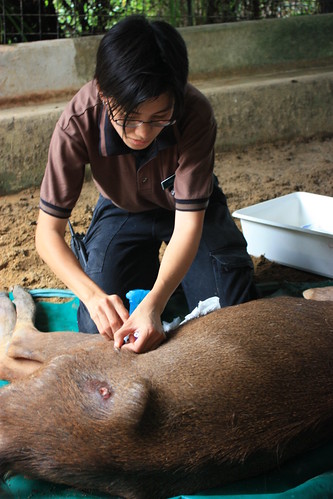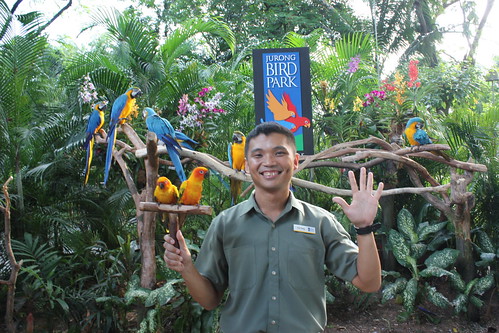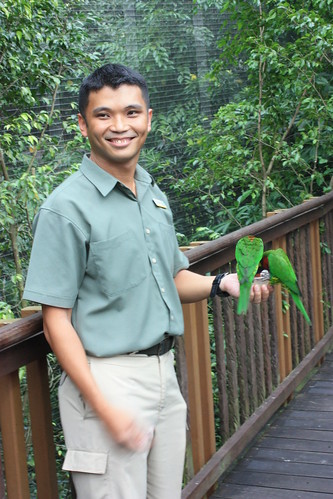How did we become Singaporean? Many would answer, "Oh, I was born here'' or, "my parents migrated here a long time ago. " Before we were born we could have been conceived in the womb of a mother in so many other countries. If we were to think of it this way, we'd realise that it's actually by a miniscule chance that we're born into this little red dot. So what led to our birth in this cosy little isle floating over the vast oceans? For some it's simple, for others it's convoluted.
Take a look at this interesting article on how this Singaporean ended up being born here in the first place.
Accidental histories, purposeful futures
I am an accidental Singaporean, born here through a quirk of fate. My father loved his hometown in Kerala, South India, and had had no intention of packing off to that British outpost in the east. In 1948, it was instead an older brother who had a ticket for Singapore. With just days to go before the voyage, that brother was struck by a bout of inertia and refused to budge. There was a paid one-way ticket and a packed trunk for the taking.
My father stepped forward, boarded the train to Madras, took the steamship Rajula across the Bay of Bengal, spent three weeks quarantined on St John’s Island along with other third class passengers, then landed at Clifford Pier. He returned to India to marry my mother, but Singapore was where they spent their entire working lives and where they raised their family, thanks to that snap decision my father took when he was 22 years old.
My wife has a different heritage, but is also an accidental Singaporean. Her grandmother and mother were living contentedly in Medan, Sumatra, as the Pacific War broke out. When Singapore fell to the Japanese, my wife’s grandmother picked up her only child and headed for the eye of the storm. The steely matriarch wanted to look for relatives that had gone incommunicado when the Japanese invaded. She and her daughter would remain in Singapore the rest of their lives.
As for my wife’s father, he was born in Singapore but was not supposed to stay. When he was nine, his father, heartbroken by the death of his wife, decided to return to his village. He would leave behind his older sons but he wanted to take his youngest – my wife’s father – with him.
As father and son were climbing the gangplank to the steamship departing Singapore (and it’s probably more than a flight of fancy to want to believe that this was the same vessel that brought my own father here), the boy turned tail, ran back down, planted himself back on the Singapore shore and declared that he would stay with his brothers.
Thus, through a set of spontaneous, unscripted events, my wife and I were born citizens of what must be the most totally planned city state in the history of human civilisation. Other Singaporeans have similar tales, adding multiple layers of irony to the country’s history. On National Day, there’s a natural desire to flatten and straighten those stories into a simple narrative, but I’m more fascinated by the twists and turns that got us here.
In any case, at the end of the day how we ended up being Singaporean is one issue, how we strive together for Singapore as Singaporeans is another. It is not by fortuity or sheer luck that Singapore has become what we are today. As Chapter 5 ,"Fast Forward", of our NDP show depicts, Singapore rose to become a first-world nation from a thrid-world country, she progressed from mangrove to metropolis! This would not have been possible without the copious sweat, blood and tears our forefathers shed for us to build a strong foundation for our nation. Neither would it have been possible without our county's leaders and the hard work and dedication of our people.
 Every Singaporean had and has a part to play in the success of our nation. It is not by accident that we've become the successful Singapore that we are today. Not accidentally Singapore.
Every Singaporean had and has a part to play in the success of our nation. It is not by accident that we've become the successful Singapore that we are today. Not accidentally Singapore.Here's another engaging article that talks about how Singapore, a multi-racial country, has made a stand in the world. This is because her people work hand in hand. The prosperity we enjoy today is not pre-ordained, it's thanks to Singaporeans' diligence and determination.
 Nothing pre-ordained
Nothing pre-ordainedA new book, Singapore: A 700-Year History, has just been written by eminent local historians Kwa Chong Guan, Derek Heng and Tan Tai Yong. It’s not at the bookshops yet, but my friend Kevin Tan has read a review copy and welcomes its fresh approach.
“You will not find a progressive narrative that sees Singapore's history as an inexorable journey from its humble founding to its present destiny,” Tan writes in his review for The Straits Times. Instead, he says, the historians have taken a long view, showing how “Singapore and its population have had to struggle to respond to the shifting sands and changing winds of its environment and location”.
From this historical perspective, everything is tentative: “Nothing is taken for granted; nothing is pre-ordained and nothing is inevitable.”
I don’t know if this book will be a best-seller or if it will filter down to the teaching of social studies in school. However, it seems to fit my own sense of the accidental quality of being Singaporean. To appreciate this city is to understand the entrances and exits of empires and entrepreneurs, the myriad decisions of geopolitical strategists and humble fortune seekers, in war rooms, board rooms, ports and faraway villages, all putting their imprints on the way we are.
There are some who believe that more homogeneous and static societies make stronger nations. They envy countries of one race, one language, one religion. That, though, is a hopelessly outdated view, and not only because no such country exists. Today, with relentless globalisation, Singapore’s legacy as a confluence of cultural streams and historical forces is its greatest strength.
If countries had DNA, ours would show a degree of hybridity and adaptability that others can only wish for. It is a trait that allows us, instinctively, to see opportunity in change.
That DNA also makes us the least status-ridden society in Asia. We are relatively free of the feudalism that infects our immediate neighbours in Southeast Asia, less burdened by the distinctions of caste, credentials and connections that taint public life in India, and less consumed by the cult of wealth that rules the new China.
Thus, most Singaporeans would find it unconscionable if any family suffered extreme poverty to the extent of being homeless or denying the children an education. Equally, we do not tolerate the ostentatious shows of wealth that the elite elsewhere in Asia are used to flaunting.
As a society with a centuries-old heritage of physical and social mobility, we are developing an instinct for justice and fairness. Most Singaporeans cannot stomach the notion that some people deserve to be stuck at the bottom, and we get offended if the rich confuse their good fortune for entitlement.
I’m not saying that our positive national traits have deep roots. Whether or not we are able to nurture them depends partly on whether we recognise them as strengths, and even more on whether we believe that there is a “we” in the first place. It won’t happen if Singaporeans see themselves as nothing more than accidental co-inhabitants of an overcrowded place, secretly wishing that people who are different would become like them or just disappear. Instead, we need to treasure the gift that is society.
Our arrivals and those of our forefathers may have been impelled by economic need or war, or as impulsive as the decision of a young man who is suddenly offered a ticket and a trunk. As for being born Singaporean, the odds are something in the order of 0.05 percent.
Yet, there is more to the Singapore story than caprice and chance. However they got here, Singaporeans did not just sit back waiting for history to be made for them. Families and communities worked hard to make their lives better, and to improve the prospects for the next generation. Doing it in a multi-ethnic milieu posed special challenges, but only on very rare occasions was the friction explosive.
Thus, the legacy passed down to today’s Singaporeans isn’t one of random opportunism. It is a commitment – expressed formally in the Pledge but honoured mainly in practice – to turn this diverse collection of individuals into a society where we protect one another, help one another achieve our dreams, and work together to care for the nation we share.
There is nothing accidental about it.
Cherian George is an associate professor at Nanyang Technological University’s Wee Kim Wee School of Communication and Information. He is the author of Singapore: The Air-Conditioned Nation and blogs at cherian.blogspot.com and elsewhere. He contributed this piece to ndp.org.sg.
-------
And lastly, an article to spice it all up. :) This one tells us of the historical, antique and sentimental values of certain artefacts the writer keeps.
Souvenirs of a forgotten past
I collect antique maps partly because they remind me of our topsy-turvy heritage. My oldest map of Asia, a 17th century specimen, shows the Malayan peninsula (labeled Malacca) as a lumpy appendage – but no blob at its tip where Singapore should be. On a couple of later maps, including one from 1808, a misshapen Singapore is visible, but unnamed. The Singapore Strait is identified but not the island itself, indicating that the waters to our south were more noteworthy to European mapmakers than the land we now inhabit.I have another map that identifies Singapore as part of the “Indian Empire”, a memento of the period from the late 19th century when the British administered Singapore via Calcutta.
Old newspapers are harder to find, but one that I bought from my favourite antique shop in Telok Ayer is more than 60 years old. The newspaper is in English and the address below the masthead, 14 Cecil Street, indicates that it came out of the one-time premises of my former employer, The Straits Times.
But, this is not ST. Well, not that ST. Its masthead reads, Syonan Times. The date is Tuesday May 19, 2602, which is 1942 in the Japanese calendar, for this is of course a copy of the propaganda rag of Occupied Singapore. Except that according to this newspaper, it is not Singapore but Syonan-to.
My late father used to collect stamps and some of his old Singapore stamps, framed on the wall next to my maps, continue the Singapore story. There are “Malaya Singapore” stamps bearing the likenesses of King George VI, who was on the throne when my father arrived on the island, and then Queen Elizabeth II.
A stamp from 1960 bears the Singapore flag and the words “National Day” and “June 3” – thoroughy confusing Singaporean children who believe that August 9 is the only National Day that Singaporeans have ever celebrated.
-------
Welcome to this post! =D
 Animals are unique beings, each having their individual personalities and characters. They respond to love, care and concern, the same way that any other human being would.
Animals are unique beings, each having their individual personalities and characters. They respond to love, care and concern, the same way that any other human being would.
 Gurusamy Permalo, headkeeper of Singapore Zoological Gardens, is in charge of the well-being of numerous animals.
Gurusamy Permalo, headkeeper of Singapore Zoological Gardens, is in charge of the well-being of numerous animals.'The Zoo,' Gurusamy shared, 'imparts lessons.' The loss of natural habitats and wildlife is a very grave issue in today's world. Through the educational campaigns offered by the Zoo, he hopes that everyone would learn to cherish, respect and love Nature.
To see the animals thriving under his care would, to him, be one of the simplest, yet greatest, pleasures in life.
Ever since she's young, Dr Oh always wanted to treat sick animals and make them better. It's always a comfort to see sickly creatures return to full health.
However, being a vet isn't always smooth-sailing. To Dr Oh, it's heartrending to be treating animals that reject her.
Animals don't like vets - they equate the vets' presence with pain, bitter medicine and injections. It's equally distressing to treat animals that they've been working with for years, watching them suffer in ill health.
 Despite the amount of 'heartwork' involved, Dr Oh remains unfazed. She will continue to shower care and concern on the beloved animals. :)
Despite the amount of 'heartwork' involved, Dr Oh remains unfazed. She will continue to shower care and concern on the beloved animals. :)As Operations Executive for the Jurong Bird park, it is Mr Ng Kim Seng's job to ensure smooth operations in the Park.
 He does that by going around the park to check on the various exhibits and to make sure that all the facilities are in flawless conditions. The reason behind such dedication? Mr Ng wants to let guests have enjoyable experiences; his best reward for his efforts would be the smiles and gratitude of the Park's guests.
He does that by going around the park to check on the various exhibits and to make sure that all the facilities are in flawless conditions. The reason behind such dedication? Mr Ng wants to let guests have enjoyable experiences; his best reward for his efforts would be the smiles and gratitude of the Park's guests.As a 'nature lover', Mr Ng feels extremely uncomfortable if he were to dress in office garb and carry out the office work. For now, his office is the entire Jurong Bird Park and he's enjoying every moment of his work :)

-----------------------
It's often easy to forget the efforts of these people while sight-seeing. (P.S. I must confess that I only thought of the animals whenever I was at the Zoo or Birdpark. )
Behind the success of these award-winning parks are the continuous efforts of many people. Hope that our readers (aka you) would remember to thank these people for the wonderful experiences you had the next time you see them at the Parks!
Just some interesting but random photos that we love:



 (Below) Some of the zookeepers saying Hi! :)
(Below) Some of the zookeepers saying Hi! :)
Check out more photos from the Flickr albums!:
http://www.flickr.com/photos/ndpeeps/sets/72157619814167528/
http://www.flickr.com/photos/ndpeeps/sets/72157619814150066/
If you've noticed, the video was shot in France, Holland, London and Singapore! Interesting. haha. Well, there's a modicum of truth in the video with regards to Singaporean behaviour and habits. How many Singaporeans signal when changing lanes? We're busy industrious people, i guess, scurrying from place to place in our little objects of transport.
Made in 2006:
We once had to put our best foot forward so that our labour-intensive and subsequently capital-intensive industries could flourish. Today, we strive for great success in our service sectors and to become a global hub for all sorts of people around the world. Whether the era we're in is 2G, 3G or 4G, we're Singapore and we're rallied to do our best to be the best. That's who we are, the epitome that shows that size doesn't matter.
Count on Me Singapore! This song was the Singapore National Day Parade Theme Song in 1986, performed by Clement Chow.
Made in 2006:
Yup, since it's nearing National Day, there's no harm getting these patriotic tunes alive in us once again. :-) If interested, do check out a former post on the theme song of this year's NDP and past year theme songs!
Stand Up for Singapore
Reach out for your fellow man
You've got to make a stand
Recognise you can play your part
Let it come right from your heart
Be prepared to give a little more
Stand up, stand up for Singapore
Stand up for Singapore, do it with a smile
If you stand up for Singapore
You'll find it all worthwhile
Believe in yourself, you've got something to share
So show us all you really care
Be prepared to give a little more
Stand up, stand up for Singapore
Singapore our home and nation
Together with determination
Join in like we've never done before
Stand up, stand up for Singapore ( X 3 )
We have a vision for tomorrow, just believe, just believe
We have a goal for Singapore, we can achieve, we can achieve
You and me, we'll do our part, stand together, heart to heart
We're going to show the world what Singapore can be
We can achieve, we can achieve
There is something down the road that we can strive for
We are told no dream's too bold that we can't try for
There's a spirit in the air, it's a feeling we all share
We're going to build a better life, for you and me
We can achieve, we can achieve
Count on me Singapore, count on me to give my best and more
You and me, we'll do our part, stand together, heart to heart
We're going to show the world what Singapore can be
We can achieve, we can achieve
Chorus:
Count on me Singapore, Count on me Singapore
Count on me to give my best and more, count on me Singapore
( Repeat Chorus )
Together Singapore Singapore ( X 2 )






